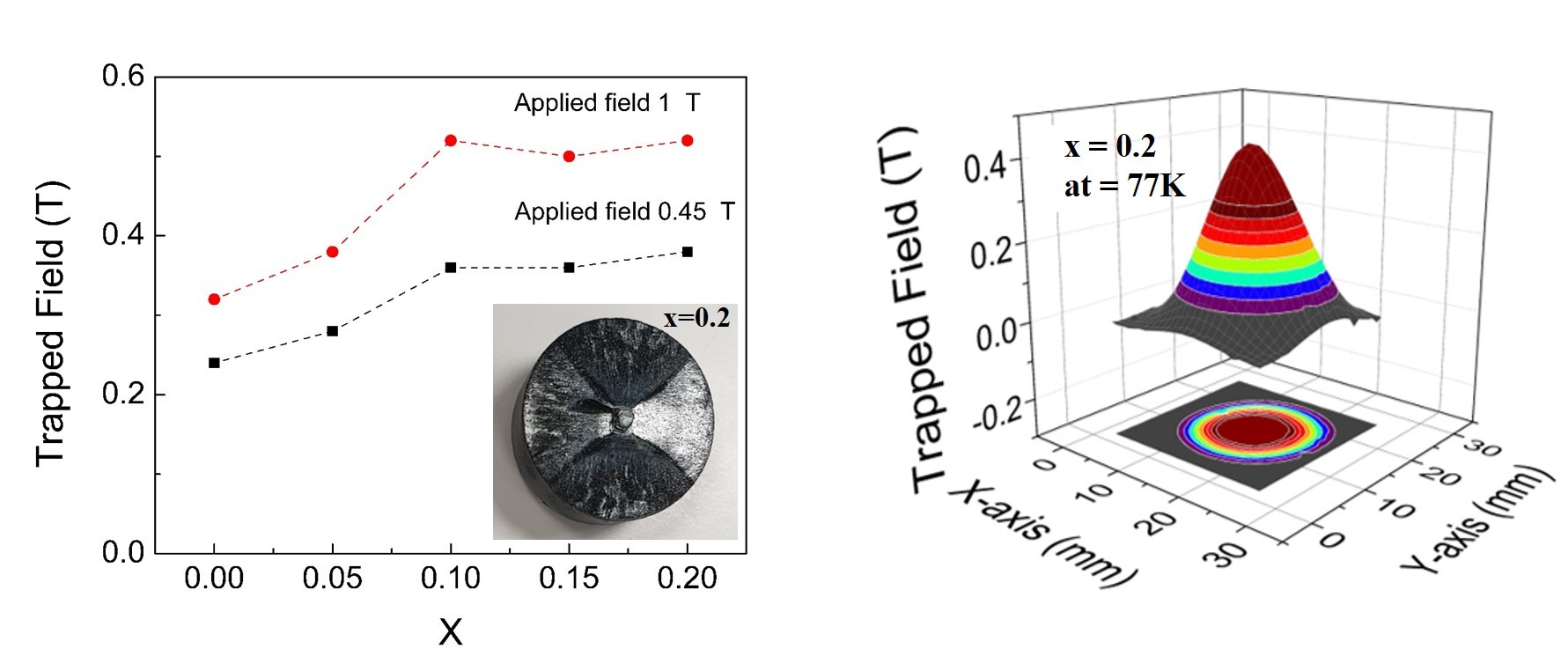On the Road to Practical, Low-cost Superconductors with Unexplored Materials
2021/06/17
- Research
Researchers from Japan report advantages of high temperature superconductivity in a mixed rare-earth elements systems prepared using trending techniques
Superconductors have tremendous appeal in power transmission applications due to their zero resistance. However, to bring classical metallic superconductors into superconducting state requires liquid helium as a coolant, which is costly. Now, scientists from Japan take things to the new level by demonstrating high temperature superconductivity in mixed rare-earth barium copper oxides fabricated using a popular technique, opening doors to their low-cost, industrial scale production for real-world applications.

Title: Trapped field values under applied fields of 1 and 0.5 T at 77K as a function of x for (Gd0.33Y0.33-xEr0.33+x)-123 samples (left). After maximum external field application, a part of it stays trapped in the superconducting bulk, making it a powerful permanent magnet (right).
Caption: Scientists systematically optimized the composition of (Gd0.33Y0.33-xEr0.33+x)-123 samples by tuning the ratio of Y and Er in the 211 precursor (specifically, x = 0, 0.05, 0.1, 0.15, and 0.2). The sample corresponding to x=0.2 showed the highest trapped field.
Credit: Muralidhar Miryala from SIT, Japan
Usage restrictions: Copyrighted
Currently, a prospective HTS material for such an exploration is (RE)Ba2Cu3Oy, RE-123, where RE stands for “Rare Earth” elements such as yttrium (Y), gadolinium (Gd), erbium (Er), neodymium (Nd), or europium (Eu). These materials in the single-crystalline form are able to overcome physical constraints that weaken superconductivity, thereby opening doors to a variety of engineering applications.
In a recent study published in the Journal of Alloys and Compounds, a team of scientists from Shibaura Institute of Technology, Japan, led by Prof. Muralidhar Miryala, a pioneer in the area of HTS, developed single-crystalline bulk superconductors that can trap magnetic fields within them in a manner similar to how ferromagnets (iron, nickel, cobalt) retain the magnetic field. “The trapped field is one of the most relevant parameters in many practical applications of bulk RE-123 and is related to the bulk diameter,” explains Prof. Miryala.
Among the several techniques available for fabricating bulk RE-123, the team went for an infiltrated growth (IG) technique, in which solid (RE)BaCuO5 (RE-211) reacts with a Ba-Cu-O liquid phase to form the superconducting RE-123. Prof. Miryala lays down the motivation behind their approach: “IG technique produces RE-123 bulks without homogeneities, can be performed in air, and scaled up to industrial levels. Moreover, it provides a fertile ground for exploring ternary RE elements systems, which have not been studied until now.”
Recently, the team investigated the ternary (Gd0.33Y0.33-xEr0.33+x)-123 bulk system, optimizing its composition by tuning the ratio of Y and Er in the 211 precursor (specifically, x = 0, 0.05, 0.1, 0.15, and 0.2). The team characterized the superconducting phases in the samples using X-ray diffraction and measured the trapped field and superconducting transition temperature (Tc). Finally, they carried out microstructural and chemical analysis using field-emission scanning electron microscope (FESEM) and energy-dispersive X-ray spectroscopy (EDX).
The XRD proved the single-crystalline nature of the RE-123 bulks, with Tc values in the range (91.5-92) K, which were significantly above the boiling point of liquid nitrogen (77K), and the highest trapped field of 0.53 tesla was observed in (Gd0.33Y0.13Er0.53)-123 (x=0.2). FESEM and EDX identified finely dispersed (Gd, Y, Er) -211 particles in all samples, with an Er-rich precipitates distribution for x=0.2, the sample which also showed the best superconducting performance.
“The findings in our study provides a notion of how to implement a low-cost production of high-performance (Gd, Y, Er)BCO bulks for real-life applications such as magnetic levitation, superconducting bearing, flywheel energy storage, magnetic resonance imaging, rotary motors, drug delivery, and water purification,” comments a contemplative Prof. Miryala.
Looks like a superconducting future may not be too far!
Reference
| Title of original paper: | (Gd,Y,Er)Ba2Cu3Oy bulk superconducting system processed via infiltration growth |
| Journal | Journal of Alloys and Compounds |
| DOI: | 10.1016/j.jallcom.2021.160535 |
Funding Information
The study was funded by Shibaura Institute of Technology (SIT) Research Centre for Green Innovation and Grant-in-Aid FD research budget code: 112282.About Professor Muralidhar Miryala
Dr. Muralidhar Miryala is a Professor at the Graduate School of Science and Engineering and Board of Councilor at Shibaura Institute of Technology (SIT), Japan. He is an active researcher in solid state physics and material science with a focus on high temperature superconductivity. His interest is in the applications and technology of bulk single-grain superconductors, RE-123 type silver-sheathed wire, DC superconducting cable, etc. He has published over 500 research items including patents, books, review-articles, and articles. He has received several awards for his research contributions including the prestigious 2021 Pravasi Bharatiya Samman Award from the Government of India.